engine coolant CHEVROLET TRACKER 1997 User Guide
[x] Cancel search | Manufacturer: CHEVROLET, Model Year: 1997, Model line: TRACKER, Model: CHEVROLET TRACKER 1997Pages: 388, PDF Size: 20.12 MB
Page 247 of 388
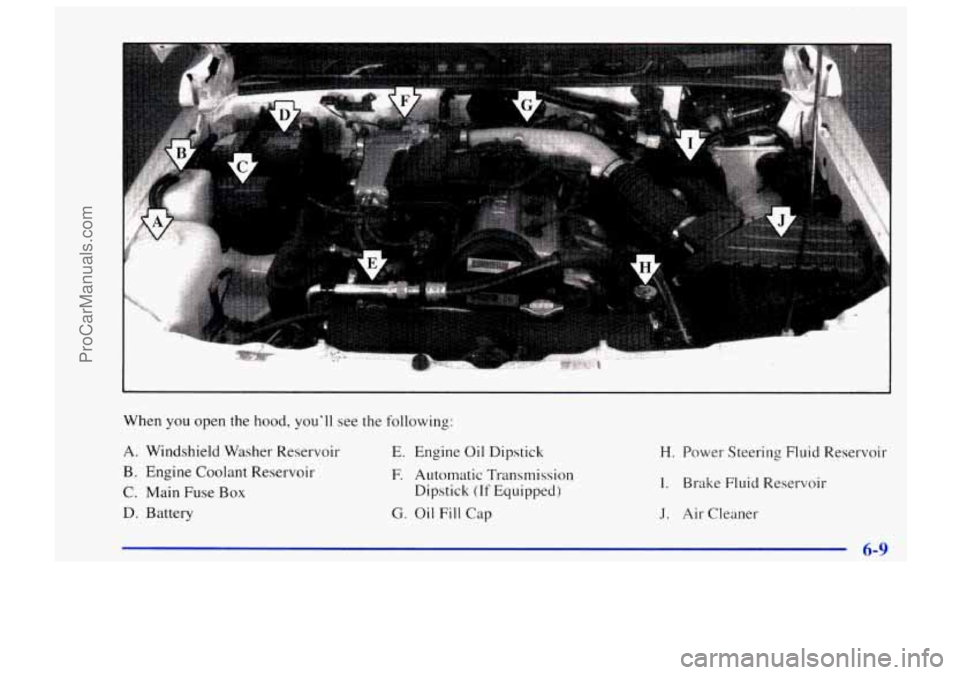
J
When you open the hood, you’ll see the following:
A. Windshield Washer Reservoir
B. Engine Coolant Reservoir
C. Main Fuse Box
D. Battery
E. Engine Oil Dipstick
F. Automatic Transmission
Dipstick
(If Equipped)
G. Oil Fill Cap
H. Power Steering Fluid Reservoir
I. Brake Fluid Reservoir
J. Air Cleaner
6-9
ProCarManuals.com
Page 261 of 388
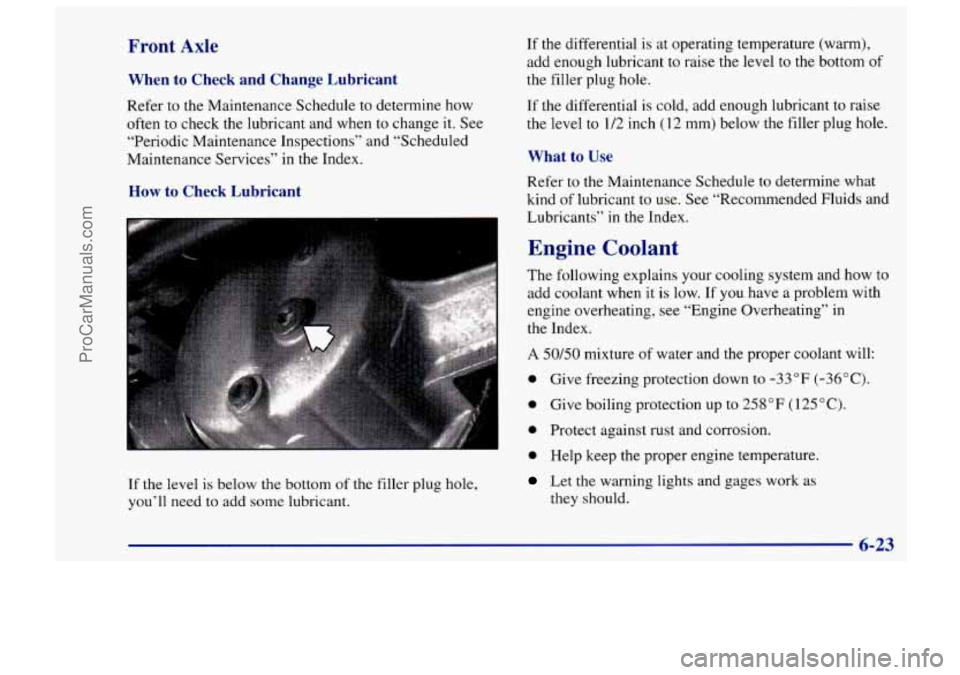
Front Axle
When to Check and Change Lubricant
Refer to the Maintenance Schedule to determine how
often to check the lubricant and when to change it. See
“Periodic Maintenance Inspections” and “Scheduled
Maintenance Services” in the Index.
How to Check Lubricant
If the differential is at operating temperature (warm),
add enough lubricant to raise the level to the bottom of
the filler plug
hole.
If the differential is cold, add enough lubricant to raise
the level to 1/2 inch
(I 2 mm) below the filler plug hole.
What to Use
Refer to the Maintenance Schedule to determine what
kind
of lubricant to use. See “Recommended Fluids and
Lubricants”
in the Index.
Engine Coolant
The following explains your cooling system and how to
add coolant when it is low. If you have a problem with
engine overheating, see “Engine Overheating” in
the Index.
If the level is below the bottom of the filler plug hole,
you’ll need to add some lubricant.
A 50/50 mixture of water and the proper coolant will:
0 Give freezing protection down to -33°F (-36°C).
0 Give boiling protection up to 258°F (125°C).
0 Protect against rust and corrosion.
0 Help keep the proper engine temperature.
Let the warning lights and gages work as
they should.
6-23
I
ProCarManuals.com
Page 262 of 388

What to Use
Use a mixture of one-half clean water (preferably
distilled) and one-half coolant that meets
GM
Specification 1825-M, which won’t damage aluminum
parts. You can also use a recycled coolant conforming to
GM Specification 1825-M with a complete coolant flush
and refill. If you use this mixture, you don’t need to add
anything else.
Adding only plain water to your cooling system
can be dangerous. Plain water, or some other
liquid like alcohol, can boil before the proper
coolant mix will. Your vehicle’s coolant warning
system is set for the proper coolant mix. With
plain water or the wrong mix, your engine could
get too hot but you wouldn’t get the overheat
warning. Your engine could catch fire and you
or
others could be burned. Use a 50/50 mix of clean
water and the proper coolant.
I
NOTICE:
If you use an improper coolant mix, your engine
could overheat and be badly damaged. The
repair cost wouldn’t be covered by your
warranty.
Too much water in the mix can freeze
and crack the engine, radiator, heater core and
other parts.
If you have to add coolant more than four times a year,
have your dealer check your cooling system.
I NOTICE:
If you use the proper coolant, you don’t have to
add extra inhibitors or additives which claim to
improve the system. These can be harmful.
6-24
ProCarManuals.com
Page 263 of 388

Checking Coolant
When your engine is cold, the coolant level should be at
LOW,
or a little higher. When your engine is warm, the
level should be
up to FULL, or a little higher.
Adding Coolant
If you need more coolant, add the proper coolant
mixture
at the coolant recovery tank, but be careful not
to spill it.
A CAUTION:
Turning the radiator pressure cap when the
engine and radiator are hot can allow steam and
scalding liquids to blow out and burn
you badly.
With the coolant recovery tank, you will almost
never have to add coolant at the radiator. Never
turn the radiator pressure cap
-- even a little --
when the engine and radiator are hot.
You can be burned
if you spill coolant on hot
engine parts. Coolant contains ethylene glycol,
and it will burn if the engine parts are hot
enough. Don’t spill coolant on a hot engine.
6-25
I
ProCarManuals.com
Page 264 of 388
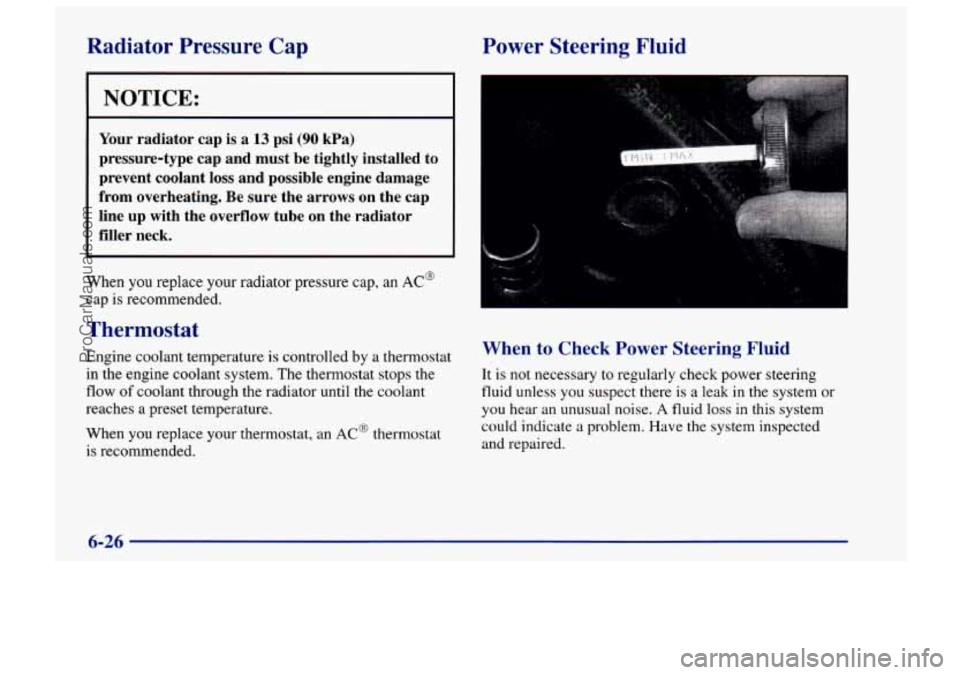
Radiator Pressure Cap Power Steering Fluid
I NOTICE:
Your radiator cap is a 13 psi (90 kPa)
pressure-type cap and must be tightly installed to
prevent coolant loss and possible engine damage
from overheating. Be sure the arrows on the cap
line up with the overflow tube
on the radiator
filler neck.
When you replace your radiator pressure cap, an AC@
cap is recommended. 'I
Thermostat
Engine coolant temperature is controlled by a thermostat
in the engine coolant system. The thermostat stops the
flow of coolant through the radiator until the coolant
reaches a preset temperature.
When
you replace your thermostat, an AC@ thermostat
is recommended.
When to Check Power Steering Fluid
It is not necessary to regularly check power steering
fluid
unless you suspect there is a leak in the system or
you hear an unusual noise.
A fluid loss in this system
could indicate
a problem. Have the system inspected
and repaired.
6-26
ProCarManuals.com
Page 316 of 388

I Short TkiplCity Maintenance Schedule I
27,000 Miles (45 000 km)
0 Change engine oil and filter (or every
3 months, whichever occurs first).
An Emission Control Sewice.
0 Inspect the locking front hubs (if equipped)
for correct operation (or every
3 months,
whichever occurs first). Repair or replace
if necessary.
30,000 Miles (50 000 km)
0 Change engine oil and filter (or every
3 months, whichever occurs first).
An Emission. Control Service.
0 Inspect engine accessory drive belts (or
every
24 months, whichever occurs first).
An Emission Control Service.
0 Drain, flush and refill cooling system (or
every
30 months, whichever occurs first).
See “Engine Coolant” in the Index for what
to use. Inspect hoses. Clean radiator, condenser, pressure cap and neck. Pressure
test the cooling system and pressure cap.
An Emission Control Service. (See footnote?.)
0 Clean and repack the front wheel bearings
(or at each brake relining, whichever
occurs first).
0 Replace spark plugs. An Emission
Control Service.
7-14
ProCarManuals.com
Page 324 of 388
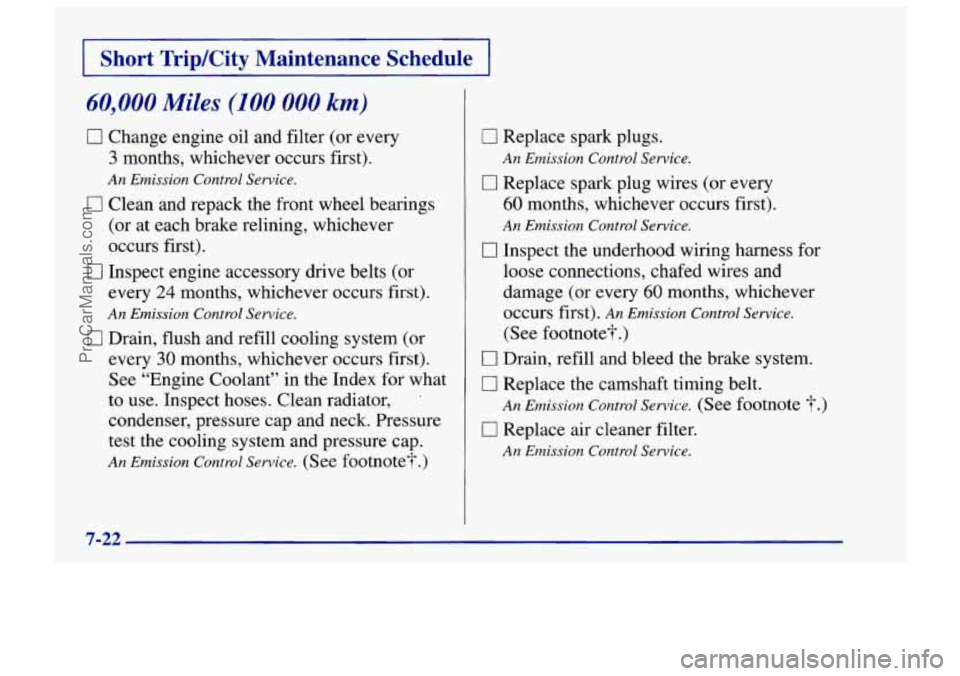
I Short TripKity Maintenance Schedule I
60,000 Miles (100 000 km)
0 Change engine oil and filter (or every
3 months, whichever occurs first).
An Emission Control Service.
0 Clean and repack the front wheel bearings
(or at each brake relining, whichever
occurs first).
0 Inspect engine accessory drive belts (or
every 24 months, whichever occurs first).
An Emission Control Service.
0 Drain, flush and refill cooling system (or
every
30 months, whichever occurs first).
See “Engine Coolant” in the Index for what
to use. Inspect hoses. Clean radiator,
condenser, pressure cap and neck. Pressure
test the cooling system and pressure cap.
An Emission Control Service. (See footnote?.)
0 Replace spark plugs.
0 Replace spark plug wires (or every
60 months, whichever occurs first).
An Emission Control Service.
An
Emission Control Service.
0 Inspect the underhood wiring harness for
loose connections, chafed wires and
damage (or every
60 months, whichever
occurs first).
An Emission Control Service.
(See footnote?.)
0 Drain, refill and bleed the brake system.
0 Replace the camshaft timing belt.
I7 Replace air cleaner filter.
An Emission Control Service. (See footnote ?.)
An Emission Control Service.
7-22
ProCarManuals.com
Page 332 of 388

Short TripKity Maintenance Schedule
90,000 Miles (150 000 km) (Continued)
Drain, flush and refill cooling system (or
every
30 months, whichever occurs first).
See “Engine Coolant”
in the Index for what
to use. Inspect hoses. Clean radiator,
condenser, pressure cap and neck. Pressure
test the cooling system and pressure cap.
An Emission Control Service. (See footnote?.)
Replace spark plugs.
An Emission Control Service.
0 Replace air cleaner filter.
An Emission Control Service.
0 Inspect fuel tank, cap and lines for damage
or leaks. Inspect fuel cap gasket for any
damage. Replace parts
as needed.
An Emission Control Service. (See footnote?.)
0 Rotate tires. See “Tire Inspection and
Rotation” in the Index for proper rotation
pattern and additional information.
(See footnote
+.)
0 Change manual transmission fluid (or every
15 months, whichever occurs first).
0 Inspect the valve lash and adjust if
necessary.
An Emission Control Service.
0 Replace fuel filter (or every 30 months,
whichever occurs first).
An Emission Control Service. (See footnote T.)
underhood label specifications.
An Emission Control Service. (See footnote?.)
0 Check engine idle speed and adjust it to
7-30
ProCarManuals.com
Page 339 of 388

Long Trip/Highway Maintenance Schedule
0 Drain, flush and refill cooling system
(or every
30 months, whichever occurs
first). See “Engine Coolant” in the Index for
what to use. Inspect hoses. Clean radiator,
condenser, pressure cap and neck. Pressure
test the cooling system and pressure cap.
An Emission Control Service. (See footnote?.)
0 Replace spark plugs.
An Emission Control Service.
0 Replace air cleaner filter.
0 Inspect fuel tank, cap and lines for damage
or leaks. Inspect fuel cap gasket for any
damage. Replace parts as needed.
An Enaission Control Service. (See footnote?.)
An Emission Control Service.
0 Change manual transmission fluid (or every
30 months, whichever occurs first).
0 Replace fuel filter (or every 30 months,
whichever occurs first,
or sooner if filter is
clogged).
An Elnission Control Senvie.
(See f.=>otnote -f-.)
0 Inspect the locking front hubs (if equipped)
for correct operation (or every
3 months,
whichever occurs first). Repair or replace
if necessary.
0 Inspect the valve lash and adjust if
necessary. An Emission Control Service.
(Continued)
7-37
ProCarManuals.com
Page 344 of 388
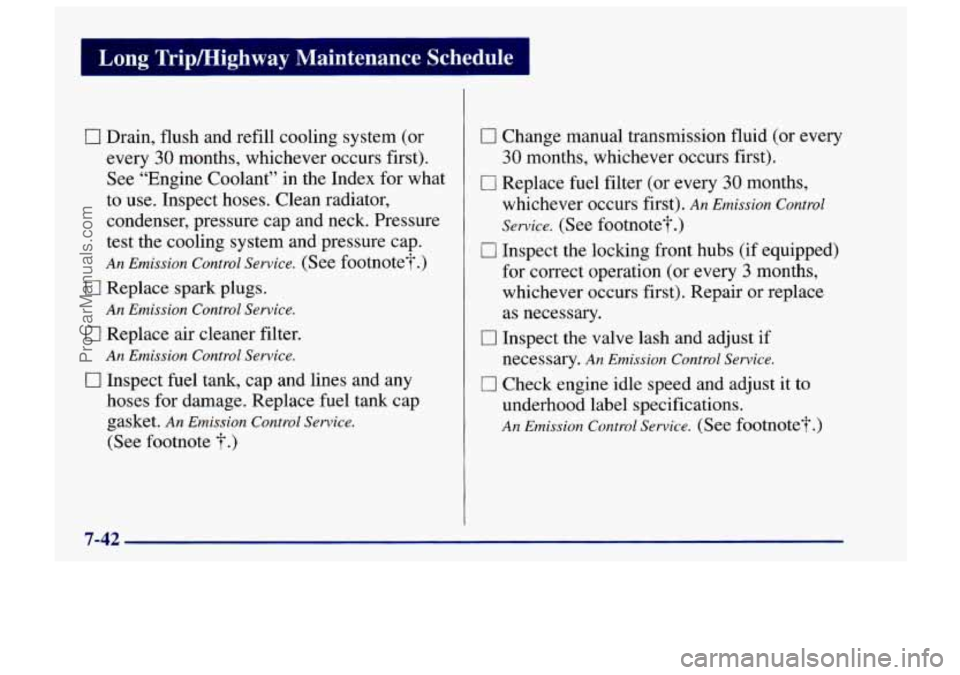
Long TripMighway Maintenance Schedule I
0 Drain, flush and refill cooling system (or
every
30 months, whichever occurs first).
See “Engine Coolant” in the Index for what
to use. Inspect hoses. Clean radiator,
condenser, pressure cap and neck. Pressure
test the cooling system and pressure cap.
An Emission Control Service. (See footnote?.)
0 Replace spark plugs.
An Emission Control Service.
0 Replace air cleaner filter.
An Emission Control Service.
0 Inspect fuel tank, cap and lines and any
hoses for damage. Replace fuel tank cap
gasket.
An Emission Control Service.
(See footnote ?.)
0 Change manual transmission fluid (or every
30 months, whichever occurs first).
0 Replace fuel filter (or every 30 months,
whichever occurs first).
An Emission Control
Service.
(See footnote?.)
0 Inspect the locking front hubs (if equipped)
for correct operation (or every
3 months,
whichever occurs first). Repair
or replace
as necessary.
0 Inspect the valve lash and adjust if
necessary.
An Emission Control Service.
0 Check engine idle speed and adjust it to
underhood label specifications.
An Emission Control Service. (See footnote?.)
7-42
ProCarManuals.com